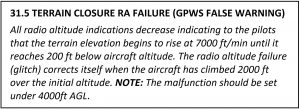The following event occurs only in the simulator, owing the nature of the simulated failure (falsely low Radio Altimeter reading leading to GPWS Terrain Alert). While that event is fun enough – couple it with a … Coupled Approach and the recovery becomes more complicated that it needs to be …
When you combine the following points together into a scenario, you get an interesting conundrum (ask me how I know this).
- Below 1500 ft RA on an ILS Approach, the AFDS APP mode ( LOC GS ) cannot be disconnected using conventional mode-selection means. If you really want to get out of APProach Mode – you have to both disconnect the autopilot and simultaneously turn both Flight Directors off. Then F/Ds back on and arm/engaged the modes you desire.
- A Terrain Escape encounter commences with disconnecting the AP and A/Thr, pitching up and manually applying maximum thrust. The TO/GA switch is not featured, and the AFDS typically remains engaged in whatever modes it was in when the Escape Manoeuvre was commenced.
 The most common means in the Simulator of simulating an unexpected terrain encounter (particularly on approach, where there seems to be a singular lack of hills and mountains to be vectored towards) is a simple IOS push button which forces the Radio Altimeter to begin to rapidly (falsely) reduce down to a value that tricks the GPWS into thinking the aircraft is about to hit something – 200 ft or less seems to be the number the RA settles on after the Terrain Warning has been triggered. Sometimes along the way you get various terrain cautions depending on altitude, aircraft configuration, etc – but this failure is basically a one-way freight train headed for a Terrain Escape Manoeuvre.
The most common means in the Simulator of simulating an unexpected terrain encounter (particularly on approach, where there seems to be a singular lack of hills and mountains to be vectored towards) is a simple IOS push button which forces the Radio Altimeter to begin to rapidly (falsely) reduce down to a value that tricks the GPWS into thinking the aircraft is about to hit something – 200 ft or less seems to be the number the RA settles on after the Terrain Warning has been triggered. Sometimes along the way you get various terrain cautions depending on altitude, aircraft configuration, etc – but this failure is basically a one-way freight train headed for a Terrain Escape Manoeuvre.
And then, finally …
- Some guy said once that when recovering from TCAS RA’s (and a few other Manoeuvre based NNMs) – FLCH is a great mode that pretty much sorts out your vertical flight directors, give you back your Auto Throttle and (as long as you have the MCP Altitude Selector set right) pretty much sorts most of your problems out – see P&T Recovering from TCAS RA (or most Manual Flight NNMs).
All this Leads to …
On approach (in APP mode) if you commence a Terrain Escape, the AFDS remains in APP mode because the TO/GA switch is not part of the procedure. Fast forward to recovering from the manoeuvre once terrain clearance is assured – if the AFDS is in APP mode ( LOC GS ) and you choose to use FLCH to recover – it will only engage if the RA fault has cleared and your Radio Altitude is back in excess of 1500 ft, no matter how quickly or how many times you press it. If you really want to use FLCH – you’ll need to cycle the Flight Directors to get out of APP mode. Or …
Previous advice aside … a better recovery technique – once you’re clear of terrain and have an appropriate pitch/speed – tends to be to accomplish what you probably would have done earlier if you’d had more time and the GPWS warning hadn’t got in the way – commence a go-around.
A brief comment to your flight deck friend helps “Ok, we’re clear of terrain let’s turn this into a Missed Approach – set Altitude 7000” and once you have decent altitude to aim for – “Go-Around, Flap 20” – trigger the TO/GA switch(es). This leads to “Positive Rate” followed by “Gear Up” and we’re off into a normal go-around manoeuvre.
Note : It’s not unusual to end up below Vref during an Approach-to-Terrain Escape Manoeuvre. The QRH tells us to “When clear of the terrain, slowly decrease pitch attitude and accelerate” – and this is pretty good advice. A suggested technique is once clear of terrain leave the thrust where it is and lower the pitch attitude towards 10°. Once the Airspeed is above Vref, commence your Go-Around (don’t forget the TO/GA switches to get out of LOC GS ).
Ken.
If you find my content useful and are in a position to do so – I would appreciate a contribution to my PayPal account (ken.pascoe@gmail.com) – If you use the Friends and Family feature in PayPal it reduces the charges to the transfer. Please note that when sending money in this way you are removing any form of purchase protection, which is not relevant to a contribution of this type anyway.
